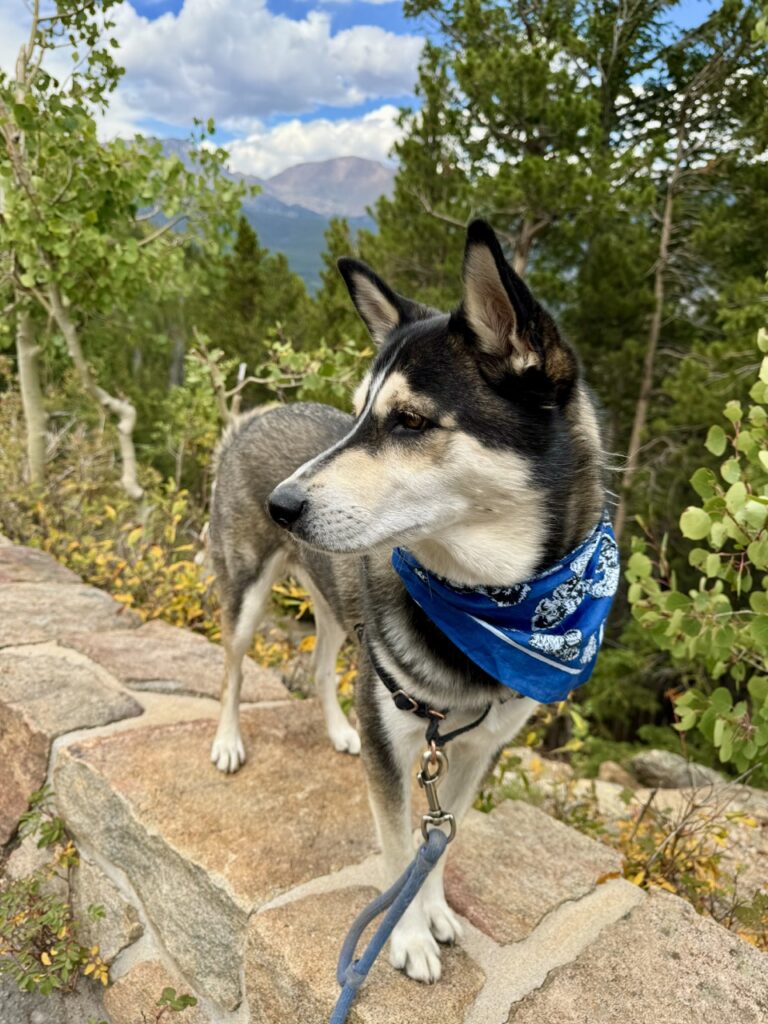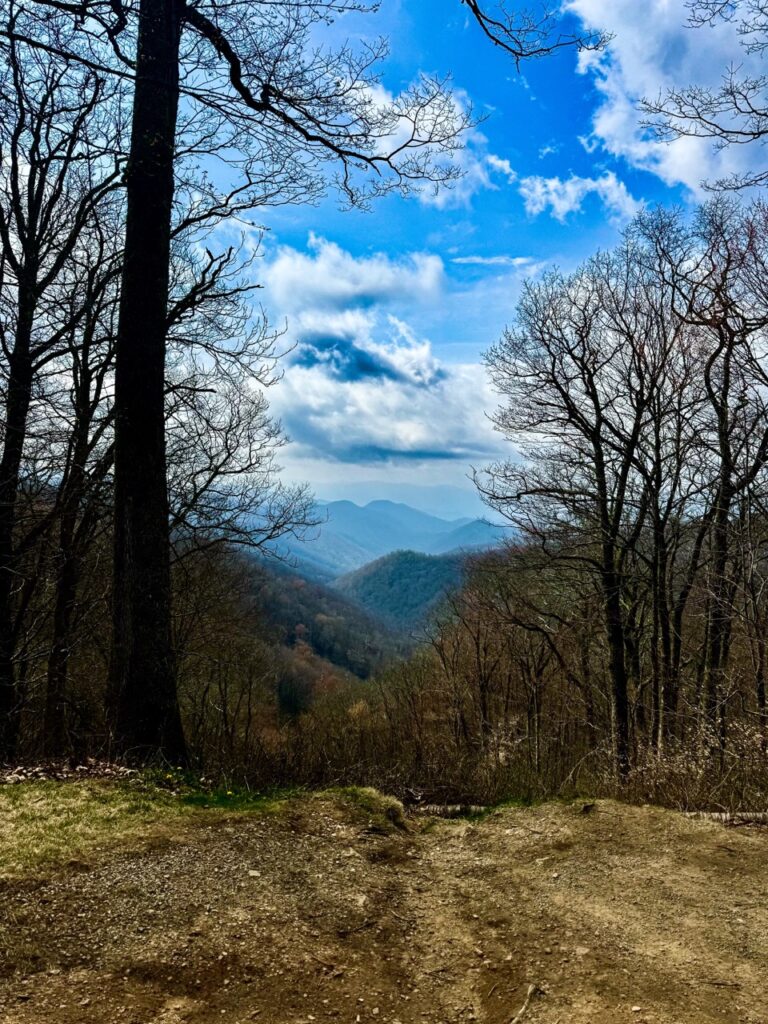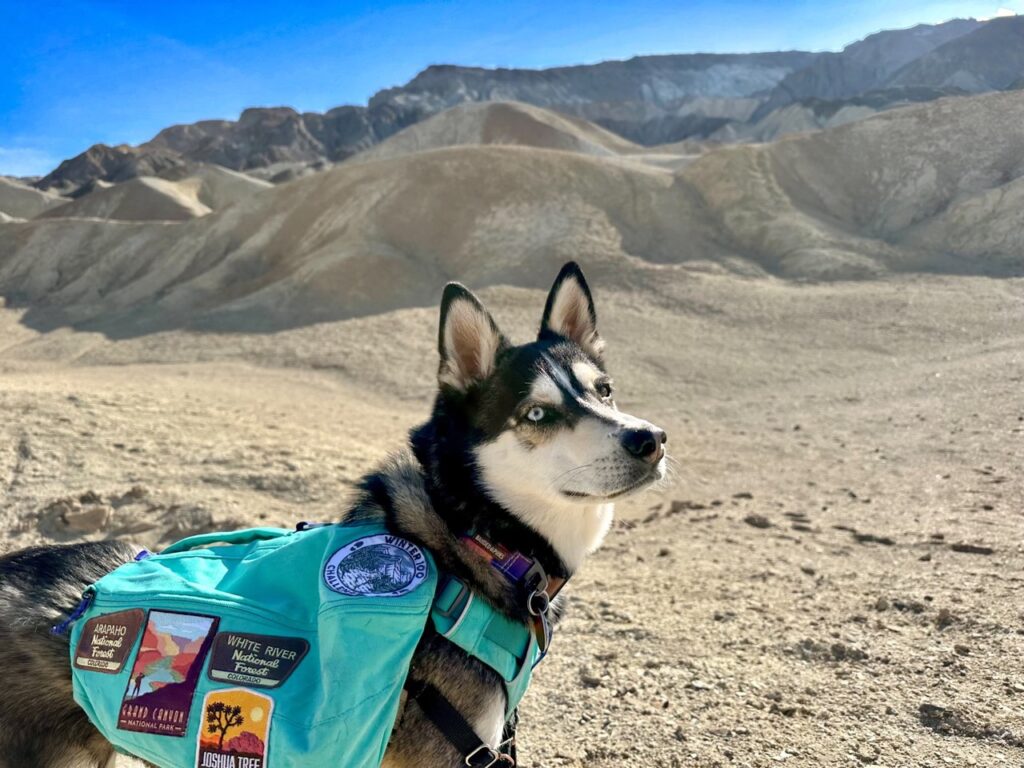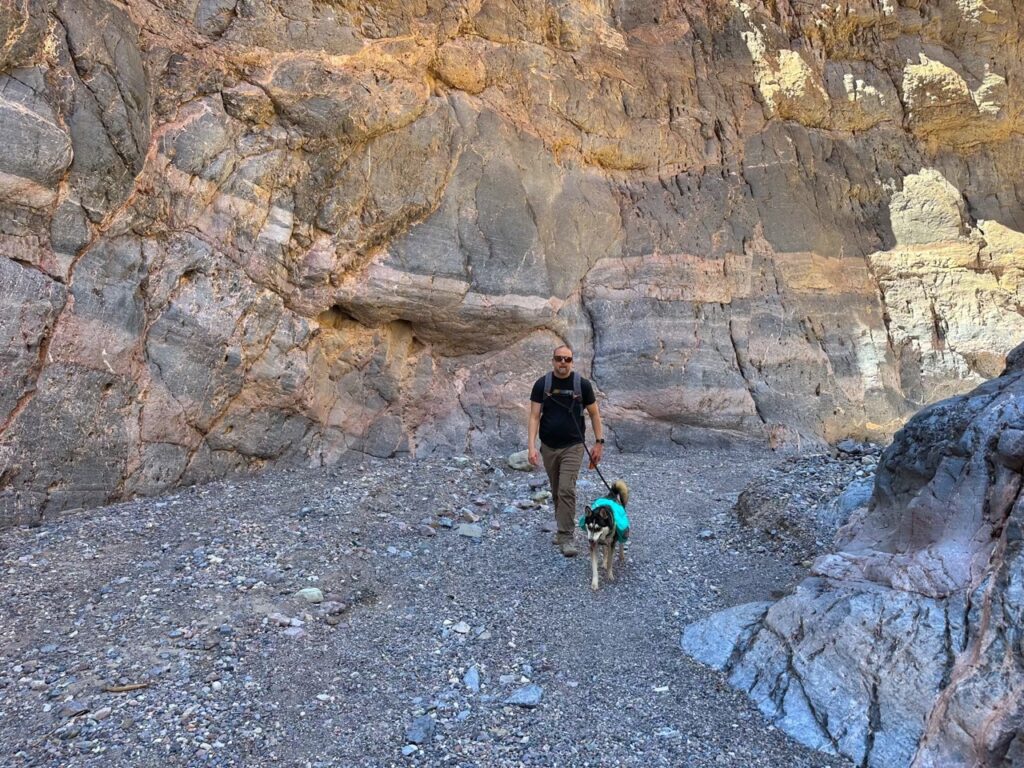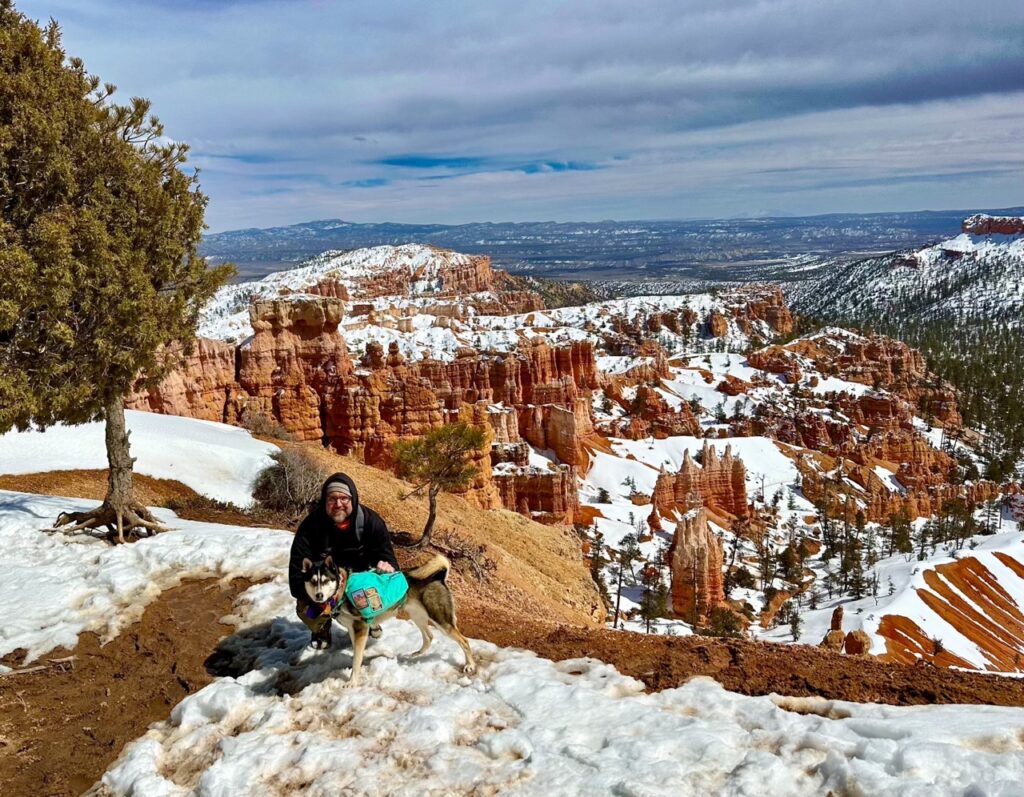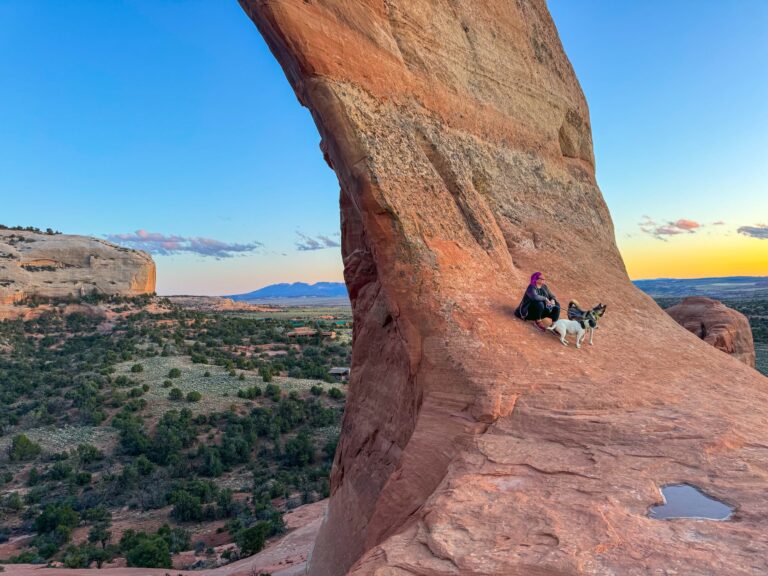Guide to visiting (nearly) any National Park with your dog
Visiting National Parks with your dog is possible. It really is! You just have to know the tricks, strategies, and be willing to be flexible in how you’re conceptualizing the perfect National Park getaway. This post contains all of our best tips.
This site contains affiliate links, which means when you click, we may receive a small commission from your purchase at no additional cost to you. This helps us run this page and offer great content free of charge, and we only recommend products that we use and love. We appreciate you!
I want to visit a National Park, but I’ve heard you can’t bring dogs
There’s a lot of confusion and mixed information about what is and isn’t allowed at National Parks.
- “Are dogs allowed in rocky mountain national park? I’ve heard they’re not.”
- “I want to see Death Valley, but the park is not dog-friendly”
- “Is it possible to hike in the Grand Canyon with my dog?”
- “Mount Rainier is on my bucket list, but l wish I could bring my dog”
- “I want to hike amongst the redwood trees in California, but I’ve heard Redwood National Park doesn’t allow dogs on trails”
We hear these types of questions and comments all the time. And guess what? ALL of these parks are dog-friendly if you know how. There are ways to visit and hike in almost any national park with your dog. It just takes a little bit of planning, and willingness to think outside the box.
The first time I started to think this way was on a road trip several years ago, when we were driving from Denver to Los Angeles. I had always wanted to explore Joshua Tree National Park. However, I was dismayed by the fact that their website stated no dogs could hike on trails in the park. We were to drive through the area in March, which promised perfectly cool weather for exploring the desert with Bonnie & Ada. As I studied the map, I noticed many backcountry roads, marked as appropriate for jeeps. Since the park’s main attraction is the trees, which I knew would be everywhere, I realized that since the park allowed dogs to walk on roads, we could easily take a lovely walk along one of these quieter roads, and experience the scenery with our dogs. My theory payed off when we gave it a try (after confirming with a ranger that this is indeed completely allowed), and we had a great time. I realized after that first experiment that I could continue to explore parks using this and other strategies, and have crafted our travels for the past several years around visiting some of the least dog-friendly parks with Bonnie & Ada.
Think your bucket list National Park is off limits? Keep reading to find out how to plan a trip to your dream destination, and bring your precious pupper along!
The importance of National Parks
National parks are so much more than pretty places for people to visit. They originated from a desire to protect natural landscapes from the rapid expansion of urbanization, industrialization, and agriculture in the 19th century. The concept began in the United States in 1872 with the establishment of Yellowstone National Park, set aside as a “public park or pleasuring-ground for the benefit and enjoyment of the people.” This groundbreaking act inspired other nations to designate their own protected areas, recognizing the value of preserving natural beauty, cultural heritage, and wildlife habitats for future generations. Over time, national parks became part of a global conservation movement, promoting not only recreation but also biodiversity protection and environmental education. The creation of national parks marked a pivotal shift toward viewing nature as something to be protected for its own sake and as a shared heritage for humanity.
National parks protect biodiversity by preserving large, undisturbed areas of natural habitats that support a wide range of plant, animal, and microbial species. These protected spaces serve as safe havens where ecosystems can thrive without the pressures of urban development, industrial activity, or agriculture, which often lead to habitat loss and fragmentation. National parks maintain ecological processes, such as pollination, seed dispersal, and predator-prey relationships, that are crucial for the health and resilience of ecosystems. Additionally, by regulating visitor impact and monitoring species populations, national parks help prevent overexploitation and manage invasive species, further ensuring the survival of native species. This biodiversity not only supports ecological balance but also strengthens ecosystems’ ability to adapt to changes, such as those driven by climate shifts.
Why many National Parks restrict dogs
National Parks often restrict dogs to protect both the natural environment and the pets themselves. Dogs can disturb wildlife by barking, leaving scents, or chasing animals, which disrupts the delicate balance of the ecosystem. Wildlife may see dogs as predators, causing stress or even abandonment of nests and young animals. Additionally, dogs can carry diseases or invasive seeds that harm local species. Park rules also protect dogs from potential dangers, such as encounters with wild animals, poisonous plants, or treacherous terrain. By limiting dogs, national parks aim to preserve a safe, undisturbed environment for native species and visitors alike.
Despite all of this, however, there is a common misconception that parks ban dogs, and that is simply untrue. Many parks place a lot of restrictions on where dogs can/can’t go, and what they can/can’t do. But no park outright bans dogs from entering at all. The biggest and most pervasive restriction is prohibiting dogs on trails and in wilderness areas. For those of us who love to hike, this can feel like a huge bummer. However, we’ve found ways to hike on all of our National Park trips without breaking any rules. Keep reading to find out how you can visit almost any park by simply following some rules and thinking outside the box.
1. Be willing to think outside the box
If you dream of hiking The Narrows in Zion , Bright Angel Trail in the Grand Canyon, or Lake Haiyaha in Rocky Mountain National Park, you’ll have to do those without your dog. In fact many of the most iconic trails in the most popular National Parks are off limits. But we think this is fine! Many of those hikes are so popular (think Angel’s Landing in Zion) and/or dangerous (think Yosemite’s Half Dome cables), that you wouldn’t really want to have your dog along anyway.
Rather than thinking of this as giving things up, shift your focus to what you’ll gain by bringing your dog to your dream National Park. We’ve found the creative thinking one has to employ when planning around park restrictions is of huge benefit. We end up hiking trails we wouldn’t normally choose, exploring outside-park public lands that we’d otherwise, and lingering at scenic picnic areas that we’d normally rush through to get to our hike.
So the first step in planning an amazing trip is to adopt a willingness to be flexible, and focus on what you CAN do, rather than lamenting what you can’t.
2. Know where you can go: How to find out a national parks rules for dogs
First and foremost, it’s important to be extremely clear about where you can/can’t take your dog in the National Park you plan to visit.
The US National Park Service provides an incredibly useful interactive map of all National Park Units (which includes National Parks, National Monuments, National Battlefields, National Historic Sites, National Seashores, National Scenic Trails, National Recreation Areas, National Rivers, National Parkways, & National Preserves)
If you don’t find what you’re looking for on the map, simply search “rules for visiting (park) with dogs”. All parks have a dedicated page explaining their rules for pets.
As you note where you CAN go, pay particular attention to rules about roads, scenic overlooks, picnic areas, and campgrounds, in addition to trails.
3. Take advantage of roads
Roads are one of the most important resources in National Parks, especially in parks that restrict dogs on trails.
Scenic Driving
One of the most accessible things you can do with your dog is to go on scenic drives, stopping along the way at scenic overlooks or other designated stopping points. Most parks allow dogs to walk around at these stops when paved, so provide multiple opportunities for sniff stops and leg-stretching.
Example: Rocky Mountain National Park
RMNP is filled with scenic drives, each with multiple pull-offs with viewpoints for dogs to jump out and sniff around.
Related posts
Rocky Mountain National Park, Colorado: Dog-friendly guide
Where to Stay in Estes Park with your Dog: Ultimate Guide 2025-2026
Example: Great Smoky Mountains National Park
Great Smoky Mountains is another park filled with roads – paved and unpaved, that you can drive with your dog, and let them hop out for sniff stops and scenic views.
Walking
ln addition to driving, however, when dogs are allowed on roads, you can often find a lot of beautiful places to explore with your pup.
Look for dirt roads in the less-accessible areas of parks. Walking along these can often give you the exact same feel as a hiking trail, while still staying within the park’s regulations.
Example: Joshua Tree National Park
Joshua Tree’s numerous backcountry jeep roads make for perfect and secluded walks with your pup, surrounded by Joshua Trees and stunning rock formations.

Example: Death Valley National Park
Death Valley is another park with tons of quiet roads that are perfect for taking your dog for a scenic walk.
4. Take advantage of picnic areas
Many designated picnic areas are quite large, and located in areas with spectacular scenery. When we visit parks, we always plan a meal at a picnic area, where our dogs can get a good long stretch of time in the fresh air to sniff around.
Example: Mt. Rainier National Park
Most of the picnic areas in Mt. Rainier National Park include a view of the star attraction – the big mountain! Your dog can join you for a leisurely picnic and walk around the paved areas.
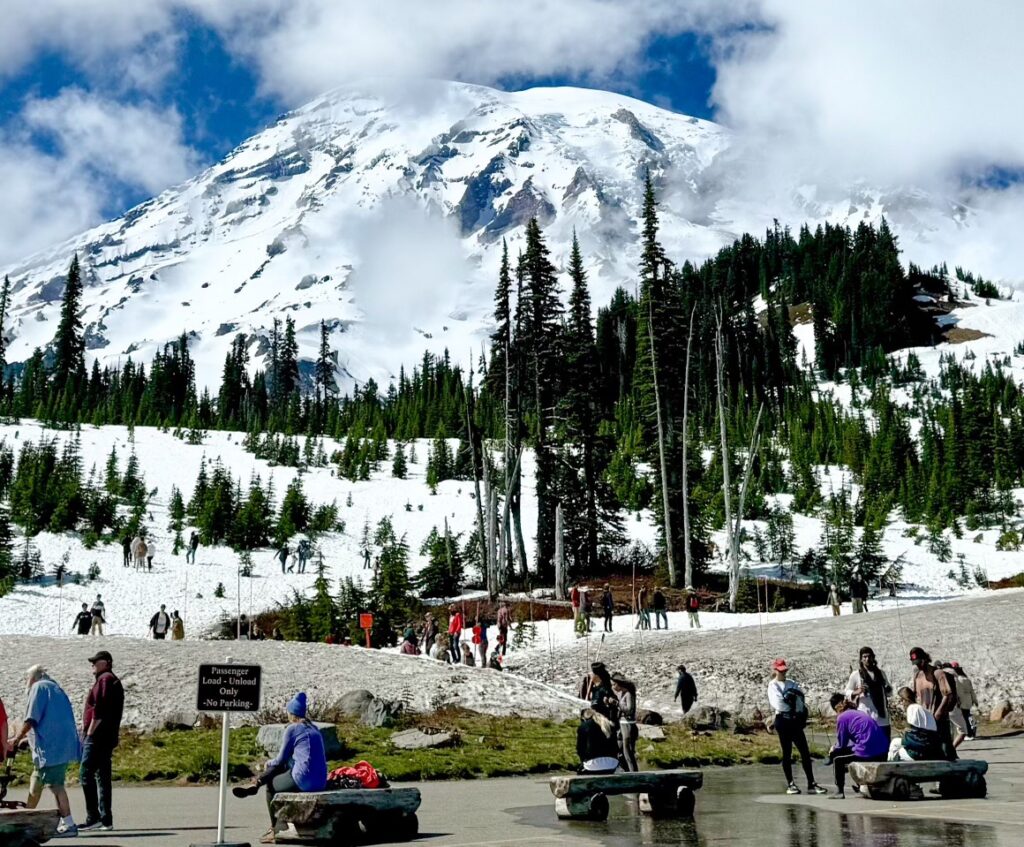
5. Take advantage of hiking on adjacent lands
Many National Parks are adjacent to other public land units – National Forest lands, BLM lands, State Parks, open space areas, etc. And many of these areas contain stunning and similar scenery as their National Park cousins – without the crowds or the rules restricting dogs. This means you can often have a very similar experience hiking in these areas, usually with only a small bit of extra driving.
Example: Saguaro National Park
While you can’t hike in Saguaro, there are numerous adjacent public lands that you can hike with your dog and see the beautiful cacti up close. We loved hiking in the Sweetwater Preserve, as well as the Coronado National Forest.

Example: Redwoods National Park
While you can’t hike in Redwoods National Park, you and your dog can hike in the adjacent Jedediah Smith State Park, and get up close and personal with the gentle giants.
Example: Arches National Park
Dogs are not allowed on trails in the park, but the surrounding area is filled with arches that are just as beautiful. Check out our blog post below for all the things you can find to do in/around this park.
Related: Guide to Visiting Arches National Park, and Moab, Utah, with Dogs
Example: Bryce Canyon National Park
You can only hike a couple trails along the rim of Bryce Canyon National Park, but in nearby Red Rock Canyon, part of the Dixie National Forest, you can hike amongst the hoodoos with your dog.
Gear up for your National Park Adventures
All of our essential hiking gear is listed in the Rockporch lockers below. Simply click and peruse! If you purchase anything from Ruffwear, use our code to save 10%: Pupperscouts10



